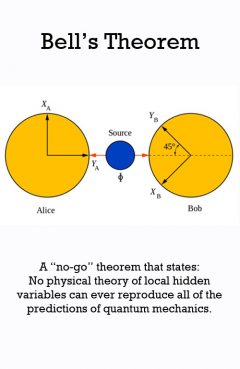Bell's Theorem

Release Date: //
Country of Release:
Length:
MPAA:
Medium: Paradox
Genre:
Release Message: Why do measured quantum particles not satisfy mathematical probability theory? Authored by J. S. Bell.
Description: Bell's Theorem Bell's theorem is a no-go theorem famous for drawing an important line in the sand between quantum mechanics (QM) and the world as we know it classically. In its simplest form, Bell's theorem states: No physical theory of local hidden variables can ever reproduce all of the predictions of quantum mechanics. When introduced in 1927, the philosophical implications of the new quantum theory were troubling to many prominent physicists of the day, including Albert Einstein. In a well known 1935 paper, Einstein and co-authors Boris Podolsky and Nathan Rosen (collectively EPR) demonstrated by a paradox that QM was incomplete. This provided hope that a more complete (and less troubling) theory might one day be discovered. But that conclusion rested on the seemingly reasonable assumptions of locality and realism (together called "local realism" or "local hidden variables", often interchangeably). In the vernacular of Einstein: locality meant no instantaneous ("spooky") action at a distance; realism meant the moon is there even when not being observed. These assumptions were hotly debated within the physics community, notably between Nobel laureates Einstein and Niels Bohr. In his groundbreaking 1964 paper, "On the Einstein Podolsky Rosen paradox", physicist John Stewart Bell presented an analogy (based on spin measurements on pairs of entangled electrons) to EPR's hypothetical paradox. Using their reasoning, he said, a choice of measurement setting here should not affect the outcome of a measurement there (and vice versa). After providing a mathematical formulation of locality and realism based on this, he showed specific cases where this would be inconsistent with the predictions of QM. J. S. Bell (John Stewart Bell)